The Bowery Theatre, 1826-1929
Introduction
Text-to-speech Audio
Images
The New York Theatre in 1826, designed by architect Ithiel Town (image from Manhattan Unlocked)
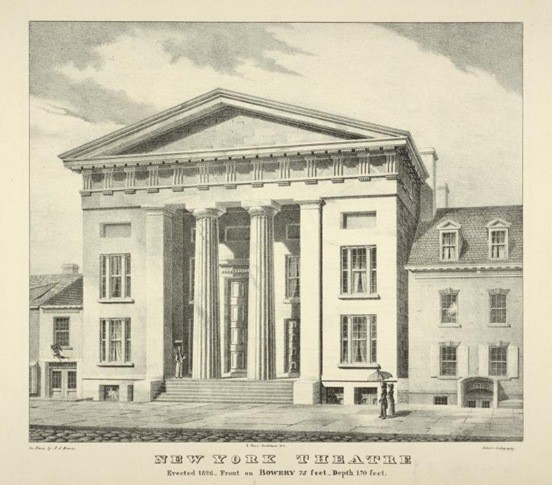
The Bowery Theatre, either the second or third building (image from Manhattan Unlocked)
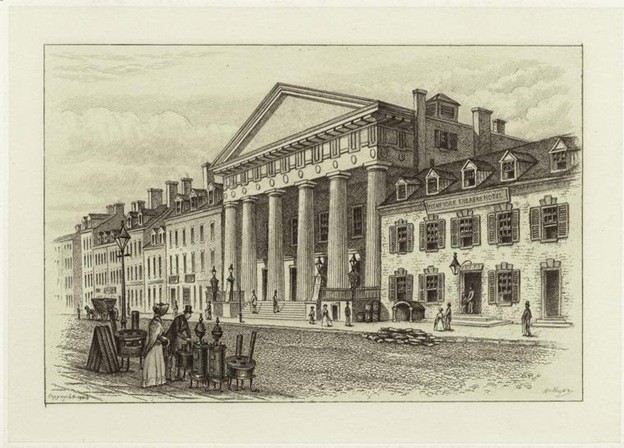
The Bowery Theatre, 1839, which stood until the 1845 fire (image from Manhattan Unlocked)
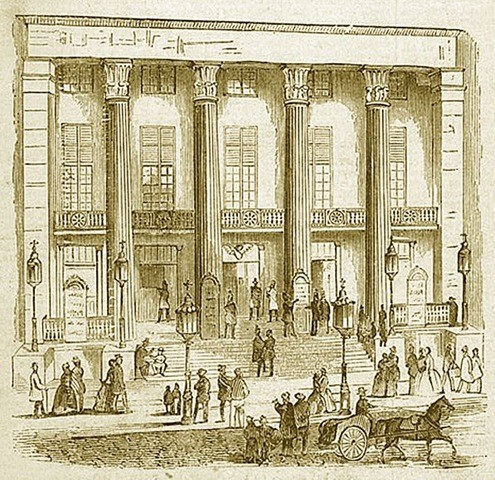
The Bowery Theatre interior in the 1850s (image from Manhattan Unlocked)
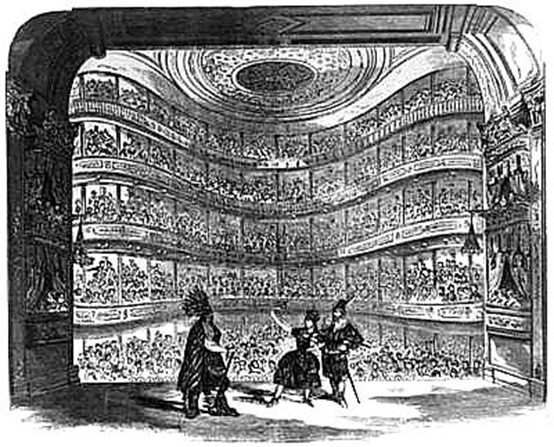
The Bowery Theatre depicted in Harpers Monthly magazine, 1871 (image from Manhattan Unlocked)
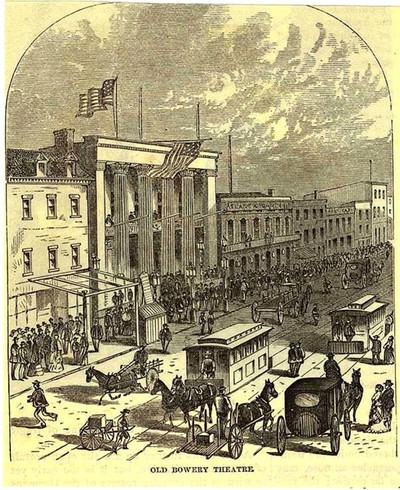
The Thalia Theatre circa 1890s (image from Manhattan Unlocked)
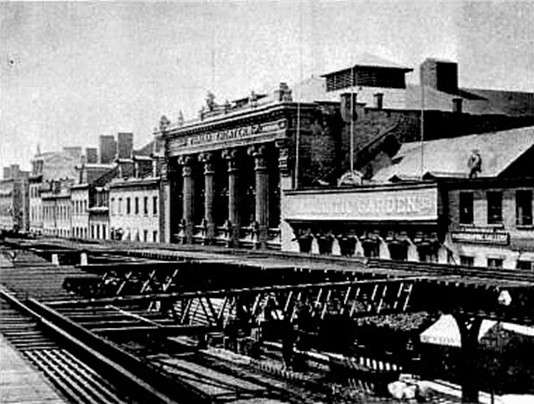
Fay's Bowery Theatre in 1928, one year before the final fire; note the el tracks in front of the building (image from Manhattan Unlocked)
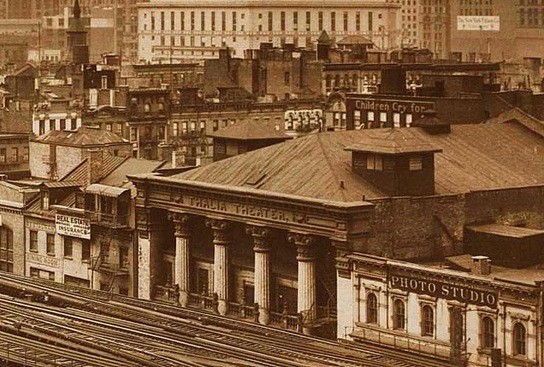
Fay's Bowery Theatre, 1928 (image from Manhattan Unlocked)
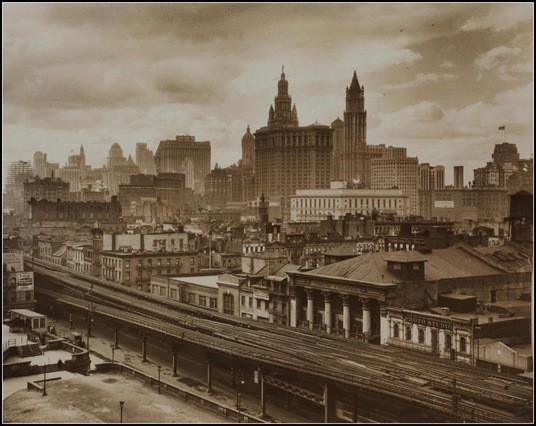
The site of the Bowery Theatre, now Jing Fong restaurant (image from Manhattan Unlocked)
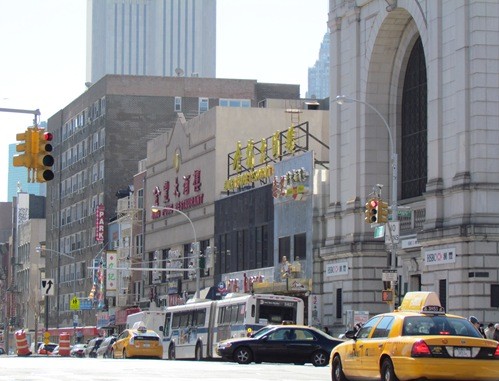
Backstory and Context
Text-to-speech Audio
The Bowery neighborhood, though already established as an entertainment district, was solidly working-class--mainly occupied by cattle-yards, slaughterhouses, butchers, and taverns--when the New York Theatre opened on October 16, 1826. Until then, most local entertainment had consisted of drinking, blood sports such as cock-fighting and bear baiting, and horse racing.
The original building was the first New York commission of architect Ithiel Town, who was noted for Greek Revival style. It was the first theater to be lit with gas-lights, and had the largest stage and house in America at the time, with a capacity to seat an audience of 3,000. The theater's backers were not disappointed in their effort to attract elite guests, though tradesmen and working-class locals attended shows regularly, too--some of the notable audience members included Walt Whitman, Charles Dickens, and Presidents Adams, Jackson, Van Buren, and Tyler. Whitman noted the "long-kept-up tempests of hand-clapping peculiar to the Bowery--no dainty kid-glove business, but electric force and muscle from perhaps 2000 full-sinew'd men," [5].
The first performance at the New York Theatre was a play entitled The Road to Ruin. Shakespeare was performed along with comedy, melodrama, and musical performances. In May of 1828, the theater was destroyed for the first time, by a fire which spread from a nearby livery stable. Rebuilt by August of the same year, the original marble building was replaced by a stucco structure with seating for an additional 500 theatre-goers. Officially renamed the Bowery Theatre, the establishment offered affordable, fixed prices and the addition of horse shows and novelty acts to its repertoire. For better or worse, the theatre was an early venue for Thomas "Daddy" Rice, who popularized minstrel shows as a form of theatre; he became a regular performer at the Bowery in 1832. The first annual Volunteer Fire Department's ball was held at the Bowery Theatre in 1829; many of these volunteers belonged to the Bowery Boys gang, who were headquartered next door to the theatre.
Despite (or because of) its association with the Bowery Boys and the fire department, the second incarnation of the Bowery Theatre burned down on September 22, 1836, and was rebuilt the following year, reopening in January of 1837. The Doric architecture of the new building was modeled after the Temple of Athena in Greece, with accommodations for a menagerie and circus called the Bowery Zoological Institute; performances of Shakespeare were interspersed with variety shows and the unique Five Points invention, tap dance, which was born of a blend of the African American and Irish American cultures residing in the area. African American tap-dancer Master Juba (aka William Henry Lane) was a regular performer at the Bowery Theatre (among others) until his death at age 27 in 1852.
In spite of the 1837 depression, when the Bowery Theatre burned down (yet again) in 1838 and again in 1845, it was rebuilt in grand size and scale, though in the coming years it would increasingly cater to working class, rather than elite, patrons. New York City theater, in general, shifted away from upper-class, educated audiences, and the Bowery Theatre was no exception. Perhaps, in part, the need for spectacle over wit was due to the influx of immigrants during this time period, as shows would need to appeal across language barriers. Nevertheless, the Bowery Theatre was criticized often in James Gordon Bennett Junior’s Herald for its "hack" performances. The character of Mose the Fireman, New York's all-American tall tale folk hero, debuted on stage in 1848 (though not at the Bowery Theatre). Mose was depicted as a stereotypical Bowery Boy with a "stove pipe hat and soap locks" [3], who rescued women, children, and tourists from trouble in the big city; he quickly became a favorite at the Bowery Theatre. Shakespearean actor Edwin Forrest (famous, in part, for instigating the Astor Place Riots of May 10-11, 1849) appeared regularly at the Bowery, where his Americanized performances of Shakespeare's characters made him popular with the local audiences.
After
the Civil War, variety shows and Westerns (such as Buffalo Bill shows) became
popular, and though the Bowery Theatre was sold and re-sold several times
between the 1850s and late 1870s, it was able to keep up with the times and
remained "well-attended" [3]. The Bowery Theatre became the Thalia Theatre
on September 11, 1879. William Kramer, who owned the Atlantic Garden (a German
beer garden of substantial proportions, opened in 1859) opened the Thalia with
entirely German-language programming, primarily plays and operas. Subleased for
the year of 1889-1890 to H. R. Jacobs, a Jewish company of actors performed in
Yiddish during the season. The Thalia featured Italian vaudeville from around
1915 until the 1920s, when it began featuring Chinese theatre instead. When it
burned down for the last time in 1929, it was under the name of Fay's Bowery
Theatre.
